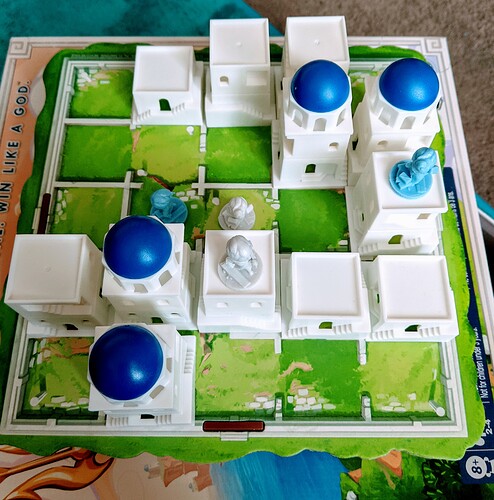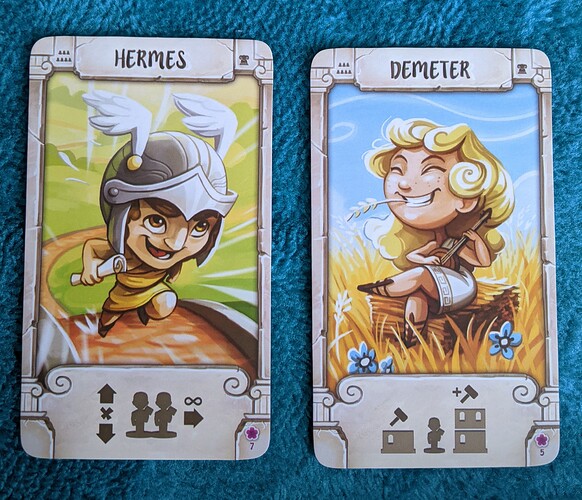Gloomhaven: Jaws of the Lion , still slogging away on this. This mission had spawning enemies ,and that’s always a lot of fun (no, not really). We destroyed the required objectives, but still needed to kill all of the enemies as well. When I was exhausted I think there was still 7 elite enemies left, and i thought we had no hope. But somehow the others managed to whittle them down, until there was only one left, and only one of us left. Just needed one more hit and…he turned up a curse card. To be so close, and then fail at the end, after 3+ hours. I’m a bit over Gloomhaven, to be honest, but my group likes it, and I’m sure there are games they play because I like them, so it works out.
Durian , first play. New game from Oink Games, which are usually pretty good fun. In this, you are creating orders for four different types of fruit (obviously Durians are represented). At the start, you each get a card, which will have a single fruit on one side, and two or three different fruit on the other. The twist is: you can’t see your own card. The players then draw cards one at a time, and create an order (using only one side of the card). Instead of drawing a card, you can ring the cute little bell and call the manager. Then everyone checks their card, and if the number of orders for a fruit exceed the actual number held by the players, the last player takes an angry manager token (numbered from one to seven). If the orders are ok, then the player who called the manager gets the angry manager token. And to confuse things, there are three gorilla cards, which will monkey around (sorry) with the orders, by swapping them, or removing any orders with bananas. Its a pretty quick game, and lots of fun.
MicroMacro: Crime City , first play. The game consists of a huge paper map of the city, and a set of 16 cases. Each case has from five to eight cards associated with it, and each card gives you an objective on the map. For example, you may need to locate a particular building, and then find someone, and maybe find out what happened to them. I’m deliberately being spoiler free here. When you think you’ve located the objective, you turn over the card to see if you’re correct. The map isnt just a snapshot of the world, you will find characters moving around, so you can see someone who might start at point A, and then they’ll go to point B, but maybe something has changed about them. Theres obviously not much replayability here once you’ve been thru the 16 cases, although there are a couple of quick missions in the rules, after you’ve solved everything else. And their website has another quick mission. Its pretty good fun, something a bit different. If you’re interested in the game, their website has a demo case to solve (doesnt need the game to play, its just online).
https://www.micromacro-game.com/en/democase.html
It’s much easier to play on the computer, because you can easily zoom in and out. And you’ll need a good look to pick up some details. The game comes with a plastic magnifier strip, and i actually picked up a couple of magnifying glasses from a $2 shop. They are both a bit awkward, and started giving me a headache. A much better solution was to enable the magnifier on my Ipad (and the others used their Iphones). I think you have to download it on Android devices.
Regicide X 2, first play. This is a game played with a standard deck of cards – but you do get some cool art if you buy it. I couldn’t see any way to buy it, so just used a generic deck. There is a deck of enemies to defeat, represented by the Jacks, Queens, and Kings. Jacks have an attack value of 10, Queens have 15, and Kings have 20. Their health is twice their attack value. The game is fully cooperative, and all you have to do is defeat the 12 cards. You can play a single card, and the value is how much damage you do. Each suit has its own power. Hearts let you add cards to the deck from the discard pile, Diamonds let you draw cards (and this is the only way to get more cards), Spades give you defense against the enemy, and Clubs are double damage. Once you’ve done damage, if you havent killed the enemy, it will attack you for its attack value (ten, fifteen, or twenty, minus any Spades you may have in play. Cards are cumulative, if you play a Spade, it will reduce damage for any other players, until the enemy is defeated.
You can play pairs, three of a kind, even four of a kind, but the total value has to be ten or less. You do the total damage, and then each suit does its own power. For example, if you play the 3 of Diamonds, Spades, and Clubs, then you will draw nine cards, reduce the enemies attack by nine, and deal 18 damage. The other way to play multiple cards is with an Ace (which is apparently an animal companion). You play it with another card. It only adds 1 to the attack value, but you get to use both the suits on the cards.
You can also play a Joker (at 3p, there is one Joker used). Each enemy card has its suit, and the special power of that suit can no longer be used. So if you’re fighting the Jack of Diamonds, you can’t draw any more cards by playing Diamonds. But playing the Joker removes that immunity.
As I said, its fully cooperative, although, as is usual with card games, you can’t tell people what you have in your hand. Its pretty difficult too. Anytime you can’t discard enough cards to resist the enemy attack – you all lose. Simple to learn, but not so easy to play. Really good fun tho, and worth picking up a $2 pack of cards to play.
Control , X2, first play. A fairly simple “take that” style of game. You play cards with values, if you finish your turn with 21 points, you’ve won. Cards have two different types – stable and unstable. Stable card abilities go off when you play the card, unstable abilities trigger when they are discarded. You can also “diffuse” a card in play by playing another card of equal or higher value. Obviously you’re meant to cancel cards as much as possible to stop people from winning. Not really our kind of game. Felt a bit underwhelming.
Durian , again. Still fun!
MicroMacro: Crime City , played the first couple of cases with another group, obviously I wasnt playing, just giving a few hints where needed. Bit awkward on my table too, not wide enough. Although you find yourself getting up out of your seat to examine the city more closely.
Regicide, again.
Signorie , a medium heavy game. This game always gives me AP, usually for no result (I don’t think I’ve ever won it). Its entertaining enough, the dice make it a different game every time. One player said he thought the game went on too long, and I’m not sure he’s wrong. There are only seven rounds, and on each round you only get four actions. But still, there’s a bit to think about, and the last rounds sometimes go on for a bit, as people grab the last remaining positions for their guys and try to maximise their score. Which I know can describe a lot of games. Anyway, I lost as usual, but got closer than I thought. It’s an interesting game, every time you take a die, there are three possible actions, one of which is to add a helper disc under another action. So you forgo doing an action, but later you’ll get more from an action.
 I offered multiple times to cut the game short, if he didn’t enjoy it. But we played the full game in the end—it has just such a good arc. I won but he claimed a level 4 tech in the final action that also gave him a fourth colony and thus two achievements to my three. I think this went really well. On the table the teach is easier than on BGA I must say.
I offered multiple times to cut the game short, if he didn’t enjoy it. But we played the full game in the end—it has just such a good arc. I won but he claimed a level 4 tech in the final action that also gave him a fourth colony and thus two achievements to my three. I think this went really well. On the table the teach is easier than on BGA I must say.



